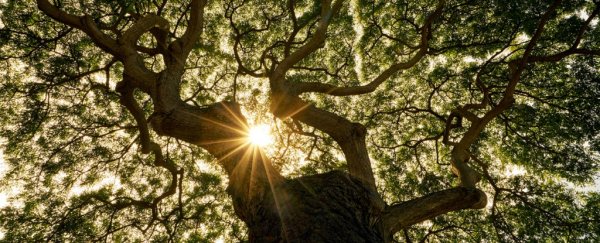The fate of Earth's forests remains uncertain. In the past few years, humans have removed more than 40 football fields of tree cover every single minute; altogether, it's an annual chunk of greenery roughly the size of the United Kingdom.
Even when these sprawls of land are replanted, something essential is lost. The more old growth we remove, the more unrecognisable these forests become.
Over the last century, a new global analysis reveals the average tree size has grown dramatically smaller with deforestation. And that's already having a profound impact on forest dynamics, global warming, and life as we know it.
"Over the last hundred years we've lost a lot of old forests," says earth scientist Nate McDowell, who works at the Pacific Northwest National Laboratory and is the lead author of the new review.
"And they've been replaced in part by non-forests and in part by young forests. This has consequences on biodiversity, climate mitigation, and forestry."
Currently, wood harvesting and land use are driving most of this destruction, but it's unlikely that climate change will alleviate our planet's waning canopy.
"This trend is likely to continue with climate warming," adds McDowell. "A future planet with fewer large, old forests will be very different than what we have grown accustomed to."
We don't know what's going to happen to these forests in the future, but the 21 authors of this review argue that continued deforestation and growing environmental threats, such as heat, drought, wildfires and disease, will only shrink Earth's trees more.
Drawing on more than 160 previous studies from around the world, the new paper carefully combs through the literature for data on recruitment, growth, and mortality of forests and woodlands.
Since the turn of the century, satellite images and deforestation studies reveal a dramatic decrease in the age and stature of forests, with a substantial increase in the amount of younger forest areas (which stand under 140 years old).
In fact, the authors say today's global vegetation biomass is only 50 percent of what it used to be because of land use changes alone.
"Overall, the net effect of historical [land use change] and wood harvest has resulted in a substantial loss of forest area, along with altered demographic rates, leading to younger, shorter, less diverse ecosystems," the authors conclude.
Scientists have been warning about this for a while. In 2012, it was discovered that California had lost 95 percent of its redwoods, while in Sweden, there was more than a 90 percent decline in large tree density; in Brazil, it was found that patches of rainforest detached from the whole typically saw a 50 percent die-off within 30 years of such isolation.
In British Columbia, loggers are still cutting down old growth despite fears of ecological collapse, and this story is playing out in nearly every corner of the globe.
Just a few years ago, the world lost nearly 4 million hectares of old growth rainforest, which is roughly the size of Belgium.
"We're seeing these forests disappear overnight," forest ecologist Michelle Connolly, director of Conservation North, told The Narwhal magazine back in January.
"It's happening so fast, and there's very little old growth left in this part of BC. It's an environmental crisis that's no less tragic than the loss of coral reefs and tropical rainforests."
When an old forest is removed, the carbon sink goes with it, and depending on how it's extracted, the carbon can be released back into the atmosphere.
The open space facilitates the establishment of small plants early on, that thrive on carbon dioxide. But the loss of these ancient pillars necessarily reduces overall species diversity, and not only does this completely shift the ecosystem, the loss in tree size and biomass diminishes the forest's carbon sink overall.
Meanwhile, our global carbon emissions show little if any improvement, and tree mortality is only getting worse.
"Unfortunately, mortality drivers like rising temperature and disturbances such as wildfire and insect outbreaks are on the rise and are expected to continue increasing in frequency and severity over the next century," says McDowell.
"So, reductions in average forest age and height are already happening and they're likely to continue to happen."
Adaptation and mitigation to these environmental shifts could potentially mitigate some of this loss. However, a tree's survival will depend on its species' genetic variation, fecundity, dispersal, population size, and environmental variability. And old growth has never experienced such profound changes before.
While the authors admit that many tree species have adapted and migrated in response to past climatic cycles, the pace of climate change today is unprecedented.
If we want to know what's going to happen to our primary forests in the future, we need to better understand how carbon dioxide, acclimation, adaptation, and migration can influence their survival and their ability to store carbon.
Because from what we know so far, it doesn't look good.
"Collectively, the evidence reveals that it is highly likely that tree mortality rates will continue to increase, whereas recruitment and growth will respond to changing drivers in a spatially and temporally variable manner," the paper concludes.
"The net impact will be a reduction in forest canopy cover and biomass."
The authors say their hypothesis should now be tested by the next generation of observational work on the ground and also from satellites.
The review was published in Science.
